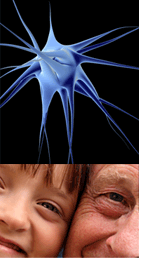 Brain plasticity—also called neuroplasticity - is the brain's ability to change at any age – for better or worse. As you would imagine, this flexibility plays an incredibly important role in our brain development (or decline) and in shaping our distinct personalities.
Brain plasticity—also called neuroplasticity - is the brain's ability to change at any age – for better or worse. As you would imagine, this flexibility plays an incredibly important role in our brain development (or decline) and in shaping our distinct personalities.
How the Brain Changes
Brain plasticity is a physical process. Gray matter can actually shrink or thicken; neural connections can be forged and refined or weakened and severed. Changes in the physical brain manifest as changes in our abilities. For example, each time we learn a new dance step, it reflects a change in our physical brains: new "wires" (neural pathways) that give instructions to our bodies on how to perform the step. Each time we forget someone's name, it also reflects brain change— "wires" that once connected to the memory have been degraded, or even severed. As these examples show, changes in the brain can result in improved skills (a new dance step) or a weakening of skills (a forgotten name).
Cognitive Growth and Decline
Often, people think of childhood and young adulthood as a time of brain growth—the young person constantly learns new things, embarks on new adventures, shows an inquisitive and explorative spirit. Conversely, older adulthood is often seen as a time of cognitive decline, with people becoming more forgetful, less inclined to seek new experiences, more "set in their ways".
But what recent research has shown is that under the right circumstances, the power of brain plasticity can help adult minds grow. Although certain brain machinery tends to decline with age, there are steps people can take to tap into plasticity and reinvigorate that machinery. We just have to keep our brains fit with a series of targeted brain plasticity exercises. Similarly, people suffering from a variety of cognitive conditions—from schizophrenia to "chemobrain"—may be able to retrain their brains to healthier function. The key—and the challenge—lies in identifying what brain mechanisms to target, and how to exercise them effectively.
Neuroplasticity and the Senses
One of the important findings of recent neuroplasticity research is the discovery of how closely our senses are connected to memory and cognition. Because of their interdependence, a weakness in one is often related to—or even the cause of—a weakness in the other. For example, we all know that Alzheimer's patients slowly lose their memories. One way this manifests is that they eat less food. Why? As it turns out, visual deficits are also a part of Alzheimer's. People eat less because they can't see the food as well. (For more on this, see Alice Cronin-Golomb's article on brain plasticity and Alzheimers.) Another example is in normal age-related cognitive changes. As we grow older, we get more forgetful and distracted in large part because our brain does not process what we hear, see, and feel as well as it once did. The result is that we can't store images of our experiences as clearly, and so have trouble using them and recalling them later.






 English
English
 Français
Français


